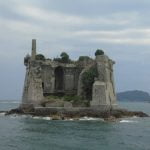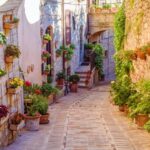Is it safe to travel to Northern Italy amidst the current situation? The recent COVID-19 pandemic has significantly impacted travel worldwide, including in Northern Italy. Local authorities and businesses have implemented various safety precautions to ensure the well-being of both residents and tourists. Despite this, travelers can still enjoy all that Northern Italy has to offer by following recommended guidelines and being mindful of their surroundings.
In response to the challenges posed by the pandemic, Northern Italy has put in place stringent safety measures to protect visitors. From mandatory mask-wearing to social distancing protocols, travelers can expect a heightened focus on health and hygiene throughout their trip. Additionally, local businesses have adapted their operations to meet these standards, providing a safer environment for tourists exploring the region.
While there may be travel restrictions or requirements for entering Northern Italy, such as quarantine rules or testing mandates, these measures are designed to safeguard public health. By staying informed about any potential restrictions and complying with them accordingly, travelers can help reduce the spread of COVID-19 while still enjoying the beauty and culture of Northern Italy. With proper planning and awareness of safety precautions in place, tourists can make the most of their trip to this enchanting region.
Safety Precautions in Northern Italy
Northern Italy has always been a popular destination for travelers looking to experience the rich culture, stunning landscapes, and delicious cuisine that the region has to offer. However, with the recent COVID-19 pandemic, many are wondering, “Is it safe to travel to Northern Italy?” The good news is that authorities in Northern Italy have implemented strict safety precautions to ensure the well-being of both residents and visitors.
Here are some safety measures that have been put in place in Northern Italy:
- Mandatory mask-wearing in public spaces
- Regular sanitization of public areas and transportation
- Social distancing guidelines in place at tourist attractions and restaurants
For travelers looking to stay safe and healthy during their trip to Northern Italy, it is important to follow these guidelines closely. Be sure to carry hand sanitizer with you at all times, avoid crowded places, and adhere to any local regulations regarding gatherings or events. By taking these precautions seriously, you can help protect yourself and others while enjoying all that Northern Italy has to offer.
In addition to following safety measures implemented by local authorities, it is also advisable for travelers to research their accommodations and activities beforehand. Look for lodging options that prioritize cleanliness and follow recommended health protocols. When dining out or exploring popular destinations, be mindful of your surroundings and choose establishments that prioritize the well-being of their guests. With a bit of preparation and awareness, traveling safely in Northern Italy is definitely possible.
Travel Restrictions
When considering whether it is safe to travel to Northern Italy, travelers must be aware of the current travel restrictions in place. As of now, there are specific entry requirements for visitors to the region due to the ongoing COVID-19 pandemic. It is essential to stay updated on any changes in regulations and guidelines set by the local authorities. Some key points to keep in mind regarding travel restrictions are:
- Checking if a negative COVID-19 test is required before entering Northern Italy
- Understanding quarantine rules or testing requirements upon arrival
- Being aware of any specific documentation needed for entry, such as a health declaration form
It is advisable for travelers to check with official government sources and airlines for the most up-to-date information on travel restrictions before embarking on their journey. By staying informed and prepared, visitors can ensure a smoother and safer travel experience in Northern Italy.
- Avoid non-essential travel if you are feeling unwell or have been in contact with someone who tested positive for COVID-19.
- Carry multiple face masks, hand sanitizers, and disinfectant wipes for personal use during your trip.
- Practice social distancing when in public places and adhere to any safety guidelines set by businesses or establishments.
Popular Destinations in Northern Italy
Northern Italy is home to some of the most iconic and breathtaking destinations in the country, making it a must-visit region for travelers. From the stunning canals of Venice to the beautiful shores of Lake Como, there is no shortage of incredible places to explore.
One popular destination in Northern Italy is Milan, known for its high-end fashion, historic architecture, and vibrant cultural scene. Visitors can admire the magnificent Duomo di Milano, shop at luxury boutiques in the Galleria Vittorio Emanuele II, and enjoy delicious Italian cuisine in cozy cafes.
Another must-see location in Northern Italy is the picturesque region of Tuscany, famous for its rolling vineyards, charming towns, and Renaissance art treasures. Travelers can visit Florence to marvel at masterpieces by Michelangelo and Da Vinci, taste authentic Tuscan dishes in local trattorias, and take scenic drives through the countryside dotted with cypress trees.
For those seeking a more laid-back atmosphere, Cinque Terre offers visitors colorful seaside villages perched on dramatic cliffs overlooking the Ligurian Sea. Hiking enthusiasts can tackle the scenic coastal trails while foodies can indulge in fresh seafood dishes at waterfront restaurants.
Furthermore, a trip to Northern Italy would not be complete without exploring the romantic city of Verona or taking a boat ride on Lake Garda, Italy’s largest lake surrounded by charming towns and stunning landscapes. Whether you are interested in history, art, cuisine, or natural beauty, Northern Italy has something to offer every type of traveler.
While considering all these enchanting destinations and experiences that await you in Northern Italy during your trip planning process – despite recent circumstances – it is essential to inquire about current travel advisories and safety measures that locals are taking so that you have an enjoyable and safe experience throughout your journey.
Accommodation Options
When considering whether it is safe to travel to Northern Italy, accommodation options play a crucial role in ensuring a secure and comfortable stay. In response to the ongoing COVID-19 pandemic, many hotels, bed and breakfasts, and vacation rentals in Northern Italy have implemented stringent safety measures to protect guests. These measures often include increased cleaning and sanitization protocols, as well as social distancing guidelines within common areas.
Travelers looking for accommodation in Northern Italy should prioritize safety when selecting their lodging. It is advisable to choose accommodations that adhere to local health and safety regulations, such as wearing masks in indoor spaces and providing hand sanitizing stations throughout the property. Additionally, opting for accommodations with flexible booking policies can provide peace of mind in case travel plans need to be adjusted due to unforeseen circumstances related to the pandemic.
In terms of accommodation options in Northern Italy, travelers have a variety of choices ranging from luxury hotels in major cities like Milan or Venice to charming agriturismos in the countryside. When selecting where to stay, consider factors such as proximity to popular attractions, access to public transportation, and the overall ambiance of the property.
By choosing a safe and secure place to stay during your trip to Northern Italy, you can focus on enjoying all that this beautiful region has to offer without compromising on your well-being.
Transportation in Northern Italy
When it comes to transportation in Northern Italy, travelers have a variety of options to choose from, including trains, buses, and rental cars. The region is known for its efficient and reliable public transportation system, making it easy for visitors to get around without the need for a car. Trains are a popular mode of transportation in Northern Italy, with high-speed rail services connecting major cities like Milan, Venice, and Florence.
Public Transportation
Travelers can make use of the extensive network of buses and trams that serve Northern Italy’s cities and towns. Public transportation is generally safe and convenient, with regular schedules and affordable fares. Many cities also offer bike-sharing programs or electric scooters for short trips within urban areas. It is advisable to check the local transport authority’s website for updated information on routes, schedules, and any special safety measures in place due to the COVID-19 pandemic.
Rental Cars
For those who prefer more flexibility in their travels, renting a car in Northern Italy is another option to consider. Rental car companies are widely available at airports and major train stations throughout the region. However, it is essential to familiarize yourself with Italian traffic laws and driving etiquette before hitting the road. Keep in mind that parking can be challenging in cities like Rome or Florence due to limited spaces and restricted zones.
Tips for Safe Travel
Regardless of which mode of transportation you choose in Northern Italy, there are some important safety tips to keep in mind. Always be aware of your surroundings and belongings while using public transportation or walking through crowded areas.
It is recommended to wear a face mask while traveling on public transport or in enclosed spaces. Additionally, staying updated on any travel advisories or restrictions related to COVID-19 is crucial before embarking on your journey to ensure a safe and enjoyable experience in this beautiful region of Italy.
Cultural Experiences
Northern Italy is a region rich in culture and history, offering travelers a wide range of unique experiences to immerse themselves in. From the stunning architecture of Milan to the romantic waterways of Venice, there is no shortage of cultural wonders to explore in this part of the country.
One of the most popular cultural activities for visitors is attending local festivals, which showcase traditions and customs that have been passed down through generations. Whether it’s the Carnival of Venice or the Salone del Gusto food fair in Turin, these events offer a glimpse into the vibrant heritage of Northern Italy.
In addition to attending festivals, travelers can also indulge in authentic food tastings to truly experience the local cuisine. Northern Italy is renowned for its delicious dishes, from creamy risottos to savory meats and cheeses.
One must-try culinary experience in this region is visiting a traditional trattoria or osteria, where you can savor homemade pasta dishes and regional specialties. Whether you’re exploring the vineyards of Piedmont or sampling fresh seafood along the Ligurian coast, the flavors of Northern Italy are sure to leave a lasting impression on your palate.
For those interested in delving deeper into the cultural significance of Northern Italy, there are various museums, galleries, and historical sites to explore. The cities of Florence and Verona are home to world-class art collections, while smaller towns like Mantua and Siena boast well-preserved medieval architecture.
Travelers can also participate in hands-on experiences such as cooking classes or artisan workshops to learn about traditional crafts and techniques. Overall, cultural experiences in Northern Italy offer a unique opportunity to connect with the local heritage and create unforgettable memories during your trip.
| Cultural Experiences | Travel Tips |
|---|---|
| Attend local festivals | Check event schedules beforehand |
| Try authentic food tastings | Explore different regional cuisines |
| Visit museums and historical sites | Book tickets in advance for popular attractions |
Local Cuisine
Northern Italy is known for its incredible cuisine that reflects the region’s diverse culinary traditions. From savory pastas to rich meats and decadent desserts, Northern Italy offers a wide range of flavors that will delight any foodie. One of the most iconic dishes from this region is Risotto alla Milanese, a creamy and saffron-infused rice dish that originated in Milan. This dish perfectly represents the simplicity and elegance of Northern Italian cooking.
When visiting Northern Italy, be sure to try some traditional dishes like Ossobuco, a flavorful and tender braised veal shank stewed with vegetables, white wine, and broth. Another must-try is Polenta e Osei, a unique dessert made with cornmeal pudding served alongside marzipan bird-shaped cookies. Whether you’re dining at a Michelin-starred restaurant or a charming trattoria, you’ll find an array of culinary delights in Northern Italy.
Pair your meal with a glass of Barolo or Amarone, two famous Italian wines that are produced in the northern regions of Piedmont and Veneto. These robust red wines are the perfect complement to the hearty flavors of Northern Italian cuisine. Don’t forget to finish off your meal with a serving of Tiramisu, a classic dessert made with layers of coffee-soaked ladyfingers and mascarpone cheese.
| Local Dishes | Recommended Restaurants |
|---|---|
| Risotto alla Milanese | Trattoria Toscana – Milan |
| Ossobuco | Ristorante Quadri – Venice |
| Tiramisu | Osteria Francescana – Modena |
Conclusion
In conclusion, Northern Italy has implemented various safety precautions to ensure the well-being of both residents and visitors amidst the ongoing COVID-19 pandemic. Local authorities and businesses have taken necessary measures to provide a safe environment for travelers, from enhanced sanitation protocols to social distancing guidelines. It is essential for travelers to adhere to these safety measures and guidelines to protect themselves and others while exploring the region.
As for travel restrictions, it is crucial for visitors to stay updated on any requirements for entering Northern Italy, such as quarantine rules or testing requirements. By being informed and prepared before their trip, travelers can navigate any restrictions seamlessly and enjoy their time in Northern Italy without any disruptions. It is advisable to check with official sources for the most up-to-date information on travel regulations to avoid any inconveniences.
Overall, while it is important to exercise caution and follow safety protocols, many popular destinations in Northern Italy are ready to welcome tourists with open arms. From the stunning landscapes of the Italian Lakes to the historic charm of cities like Venice and Florence, there is an abundance of cultural experiences and culinary delights awaiting visitors in this beautiful region.
Travelers can make the most of their trip by immersing themselves in the rich history, vibrant culture, and delectable cuisine that Northern Italy has to offer.
So, is it safe to travel to Northern Italy? With proper planning and adherence to safety guidelines, exploring this enchanting region can be a rewarding and memorable experience for anyone seeking a taste of la dolce vita.
Frequently Asked Questions
Is It Safe for Americans to Travel to Italy Right Now?
It is generally safe for Americans to travel to Italy right now, as long as they stay informed about current travel advisories and guidelines. It’s important to be aware of any potential risks or restrictions in specific regions and to adhere to local health protocols due to the ongoing COVID-19 pandemic.
What I Wish I Knew Before Going to Italy?
Before going to Italy, I wish I knew more about the local customs and traditions, especially when it comes to greetings, dining etiquette, and social norms. Understanding the language basics would have also been beneficial in enhancing my overall experience and interactions with locals.
What Does a US Citizen Need to Travel to Italy?
For a US citizen traveling to Italy, a valid passport is essential. Additionally, having travel insurance that covers medical expenses and emergencies is highly recommended.
Depending on the length of stay, a visa may be required, so it’s crucial to check the specific entry requirements beforehand. Being familiar with local currency and having access to funds through credit cards or cash is also essential for a smooth trip.

I’m a passionate traveler, writer, and Italophile. My fascination with Italy’s history, art, and culture has led me on countless adventures across the Italian landscape. Through “I Live Italy,” I share my love for this extraordinary country and aims to inspire others to explore its boundless beauty.




